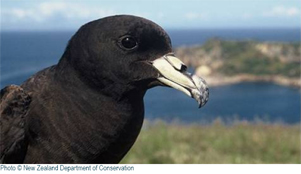It is very well known that albatrosses and the larger petrels and shearwaters fall prey to commercial longline and trawl fisheries in many of the World's oceans and seas. Less well known is what effects non-commercial, recreational fishing may have on seabirds, including those species listed within the Albatross and Petrel Agreement.
Numerous records exist of gulls and terns caught on rod and hand lines, or found entangled in fishing lines discarded or lost from shore and boats. Pelecaniform seabirds (cormorants, pelicans, gannets and boobies) also fall prey to becoming entangled in recreational fishing line and swallowing hooks. But what of the more offshore-foraging procellariiforms?
Edward Abraham and colleagues of Dragonfly Science, Wellington, New Zealand published a review in 2010 of what goes on in New Zealand non-commercial fisheries.
They report the ACAP-listed Black Petrel Procellaria parkinsoni, as well as Flesh-footed Puffinus carnepeis and most commonly Sooty P. griseus Shearwaters killed by either entanglement or hook-swallowing from recreational fishing. Hutton's P. huttoni and Fluttering P. gavia Shearwaters have also been drowned in (presumably non-commercial) set nets. Only a few albatrosses (not identified to species) were reported hooked or entangled in the review.
Following on from this review the New Zealand-based Southern Seabird Solutions Trust has been looking into the issue as it sets out in its report to next month's Fourth Session of the Meeting of Parties to ACAP, providing more information for the Black Petrel.

Black Petrel. Courtesy of the New Zealand Department of Conservation
ACAP Latest News will be pleased to publish further accounts of the effects of recreational/non-commercial fishing on albatrosses and petrels: contact ACAP's Information Officer at
Reference:
Abraham, E.R., Berkenbusch, K.N. & Richard, Y. 2010. The capture of seabirds and marine mammals in New Zealand non-commercial fisheries. New Zealand Aquatic Environment and Biodiversity Report No. 64. 52 pp.
Southern Seabird Solutions Trust 2012. Initiatives of Southern Seabird Solutions Trust. MoP4 Inf 07. 5 pp.
John Cooper, ACAP Information Officer, 6 March 2012

 English
English  Français
Français  Español
Español